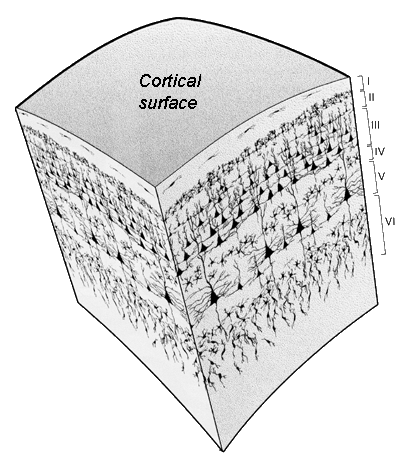I’d like you to take a moment and try to imagine how the brain works conceptually. You’re probably already familiar with cartoons depicting the functions of different areas of the cortex (shown above). Given all of these different functions of the brain it is easy to imagine that each brain area is specially designed for its function. For example, maybe the visual cortex has its neurons specially arranged to detect and communicate light, shapes, color, etc.
Indeed, this is how much what we call the “old brain” works. Our primitive brain has specialized “organs” that compute and communicate basic survival functions. From pea-sized amygdala that modulates fear and threat-response (i.e., “fight or flight”), to the Pons and Medulla Oblongata that work together to keep us breathing automatically, these parts of the brain work together to give us a strong survival instinct that is shared by the rest of the animal kingdom.
Naturally, then, one could wonder if the part that makes us uniquely human—our intelligence—works in much the same way with its own “organs” of intelligence. Last time, I introduced the neocortex and its role as the “organ of intelligence.” Given the specialized organs found within the Old Brain, does the same structure apply to the neocortex and human intelligence?
A Universal Algorithm for Intelligence
One of the most ground-breaking ideas in neuroscience over the past century was Vernon Mountcastle’s idea that all of human intelligence is based on just one universal algorithm found within what he called “cortical columns.” Below is an image of a representation of the different layers of the cortex:
Mountcastle found that the neurons were much more densely connected vertically (i.e., perpendicular to the skull) than horizontally. These are what Mountcastle called “cortical columns” which serve as the functional unit of intelligence according to his theory. No matter where in the neocortex you look—from taste to critical thinking—these same cortical columns appear and seem to compute in the same way. The only reason we can distinguish different areas of the cortex by their functions is because they are connected to different things. Take some cortical columns and connect them to the eyes and you’ll have vision. The same can be said for ears, mouth, etc…
Essentially, Mountcastle argued the radical idea that all of human intelligence can be explained by one universal algorithm found within these cortical columns. His theory is supported by a couple of observations:
The brain is very flexible. People with brain damage have the remarkable ability to to keep functionality of whichever brain section was damaged. This can only be true if other parts of the cortex are equipped to compute any function of intelligence.
There hasn’t been enough evolutionary time for human intelligence to arrive. The “Old Brain” is evolutionarily conserved in the animal kingdom and has slowly emerged over millions of years. However, humans arrived only recently and our intelligence grew remarkably quickly over our primate ancestors. Mountcastle’s universal algorithm fits this observation because the brain didn’t have to evolve specially designed intelligence organs for language, mathematics, etc… it simply had to evolve one cortical column and then make thousands of copies of the same thing all over the neocortex.
Mountcastle’s theory and data has formed the basis for decades of neuroscience research for the past few decades. How each of these cortical columns actually work is under investigation currently as uncovering this algorithm could unlock the secret to the human intelligence and have immense implications for medicine, technology, and our understanding of the nature of conscious life.
Let me know if you’re intrigued by these cortical columns and I’ll be sure to dig in more in future newsletters. Until then, thanks for reading.
⚡️P.S. If you're new here and want to read more of the Synapse Newsletter every other week, subscribe below!⚡️






So would cortical columns be essential to the plasticity of the brain? And please more about cortical columns.
I’d love to read more.